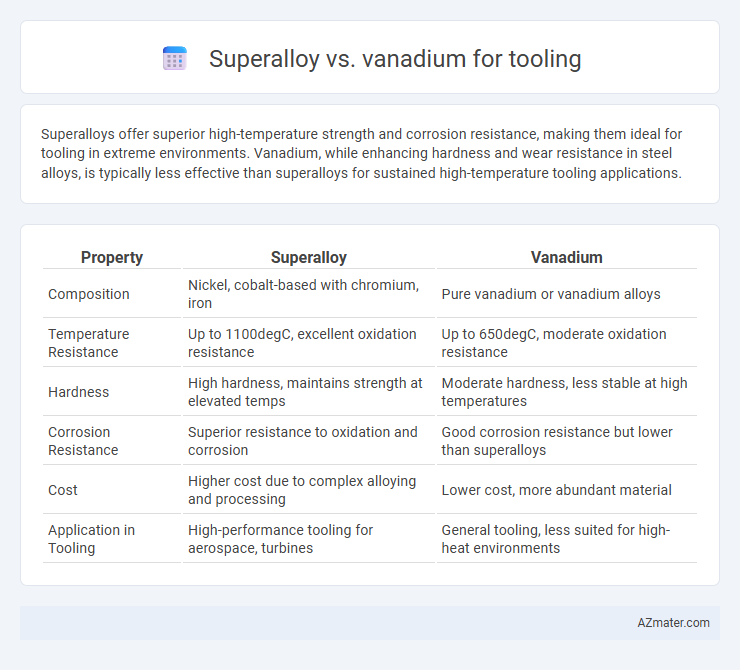Superalloys offer superior high-temperature strength and corrosion resistance, making them ideal for tooling in extreme environments. Vanadium, while enhancing hardness and wear resistance in steel alloys, is typically less effective than superalloys for sustained high-temperature tooling applications.
Table of Comparison
| Property | Superalloy | Vanadium |
|---|---|---|
| Composition | Nickel, cobalt-based with chromium, iron | Pure vanadium or vanadium alloys |
| Temperature Resistance | Up to 1100degC, excellent oxidation resistance | Up to 650degC, moderate oxidation resistance |
| Hardness | High hardness, maintains strength at elevated temps | Moderate hardness, less stable at high temperatures |
| Corrosion Resistance | Superior resistance to oxidation and corrosion | Good corrosion resistance but lower than superalloys |
| Cost | Higher cost due to complex alloying and processing | Lower cost, more abundant material |
| Application in Tooling | High-performance tooling for aerospace, turbines | General tooling, less suited for high-heat environments |
Introduction to Superalloy and Vanadium in Tooling
Superalloys, known for their exceptional high-temperature strength and corrosion resistance, are widely used in tooling applications that demand durability under extreme conditions, such as aerospace and automotive manufacturing. Vanadium, often added to steel alloys or used as a standalone element in tool steels, enhances hardness, wear resistance, and toughness, making it ideal for cutting tools and dies. Both materials contribute distinct advantages to tooling performance, with superalloys excelling in thermal stability and vanadium improving mechanical strength and lifespan.
Chemical Composition and Material Structure
Superalloys typically consist of nickel, cobalt, or iron-based matrices with high concentrations of chromium, aluminum, and titanium, providing exceptional corrosion resistance and high-temperature strength, while vanadium is primarily an element used in steel alloys to improve hardness and fatigue resistance through its carbide-forming ability. The material structure of superalloys features complex, multi-phase microstructures with gamma prime (Ni3Al) precipitates that enhance creep resistance at elevated temperatures, whereas vanadium-enhanced steels exhibit a tempered martensitic structure offering superior toughness and wear resistance. Chemical composition in superalloys enables stability in extreme environments, while vanadium additions focus on improving mechanical performance in high-stress tooling applications.
Mechanical Properties Comparison
Superalloys exhibit exceptional high-temperature strength, corrosion resistance, and fatigue resistance, making them ideal for tooling applications requiring durability under extreme conditions. Vanadium-enhanced steels provide excellent hardness, wear resistance, and toughness, which are critical for cutting tools and dies subjected to high impact and abrasion. Comparing mechanical properties, superalloys outperform vanadium in creep resistance and thermal stability, while vanadium alloys excel in hardness and tensile strength at moderate temperatures.
Heat Resistance and Thermal Stability
Superalloys exhibit superior heat resistance and thermal stability compared to vanadium, making them ideal for high-temperature tooling applications such as turbine blades and aerospace components. Vanadium, while offering good strength and abrasion resistance, tends to oxidize and lose mechanical integrity at elevated temperatures above 600degC. The enhanced performance of superalloys at temperatures exceeding 700degC is attributed to their complex composition, including nickel, cobalt, and chromium, which provide excellent creep resistance and oxide film formation.
Wear and Corrosion Resistance
Superalloys exhibit superior wear resistance compared to vanadium due to their complex composition of nickel, cobalt, and chromium, which forms a durable oxide layer protecting against abrasion and high-temperature degradation. Vanadium, while offering excellent hardness and strength, tends to be more susceptible to corrosion in aggressive environments, limiting its application in tooling exposed to chemical wear. The enhanced corrosion resistance of superalloys ensures longer tool life and reduced maintenance costs in harsh industrial conditions.
Machinability and Workability
Superalloys offer superior high-temperature strength and corrosion resistance, but their machinability is generally lower due to high hardness and toughness, requiring specialized tooling and slower cutting speeds. Vanadium, often used as an alloying element in steels, enhances wear resistance and machinability by refining grain structure and improving toughness, making it easier to machine and shape compared to superalloys. For tooling applications, vanadium-containing steels provide better workability and faster machining cycles, while superalloys contribute to longer tool life in extreme conditions despite more challenging processing.
Cost Efficiency in Tool Production
Superalloys offer exceptional high-temperature strength and corrosion resistance, resulting in longer tool life but at a significantly higher material and manufacturing cost compared to vanadium alloys. Vanadium-based tools provide a cost-efficient alternative with good hardness and wear resistance, suitable for moderate-duty applications where budget constraints prioritize reduced raw material and machining expenses. Balancing initial investment and tool replacement frequency, vanadium tooling often yields better cost efficiency in large-scale production environments with less extreme operating conditions.
Applications in Different Industries
Superalloys excel in aerospace and power generation tooling due to their exceptional high-temperature strength and corrosion resistance, enabling durability under extreme conditions. Vanadium-based tooling materials are widely used in automotive and construction industries for manufacturing cutting tools and dies, offering superior hardness and wear resistance. Each material's unique properties make them suitable for optimizing performance and lifespan in industry-specific applications.
Longevity and Maintenance Requirements
Superalloys, known for their exceptional high-temperature strength and corrosion resistance, offer superior longevity in tooling applications compared to vanadium-based tools, which can wear out faster under extreme conditions. Superalloys require less frequent maintenance due to their durability and ability to withstand thermal and mechanical stress without significant deformation or cracking. Vanadium tools, although initially cost-effective, demand more regular sharpening and replacement to maintain performance, increasing overall maintenance efforts.
Choosing the Right Material for Tooling Needs
Superalloys provide exceptional high-temperature strength, corrosion resistance, and durability, making them ideal for tooling applications exposed to extreme environments and heavy wear. Vanadium enhances steel alloys by increasing hardness, toughness, and resistance to wear and fatigue, proving valuable for high-performance cutting tools and dies. Selecting between superalloy and vanadium-enriched materials depends on the specific tooling requirements, such as operating temperature, mechanical load, and desired lifespan.

Infographic: Superalloy vs Vanadium for Tooling
 azmater.com
azmater.com